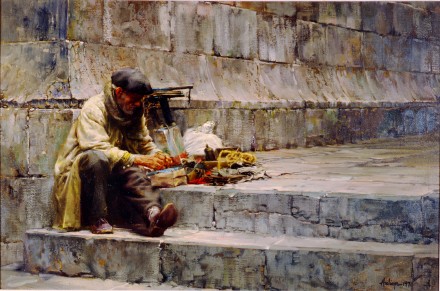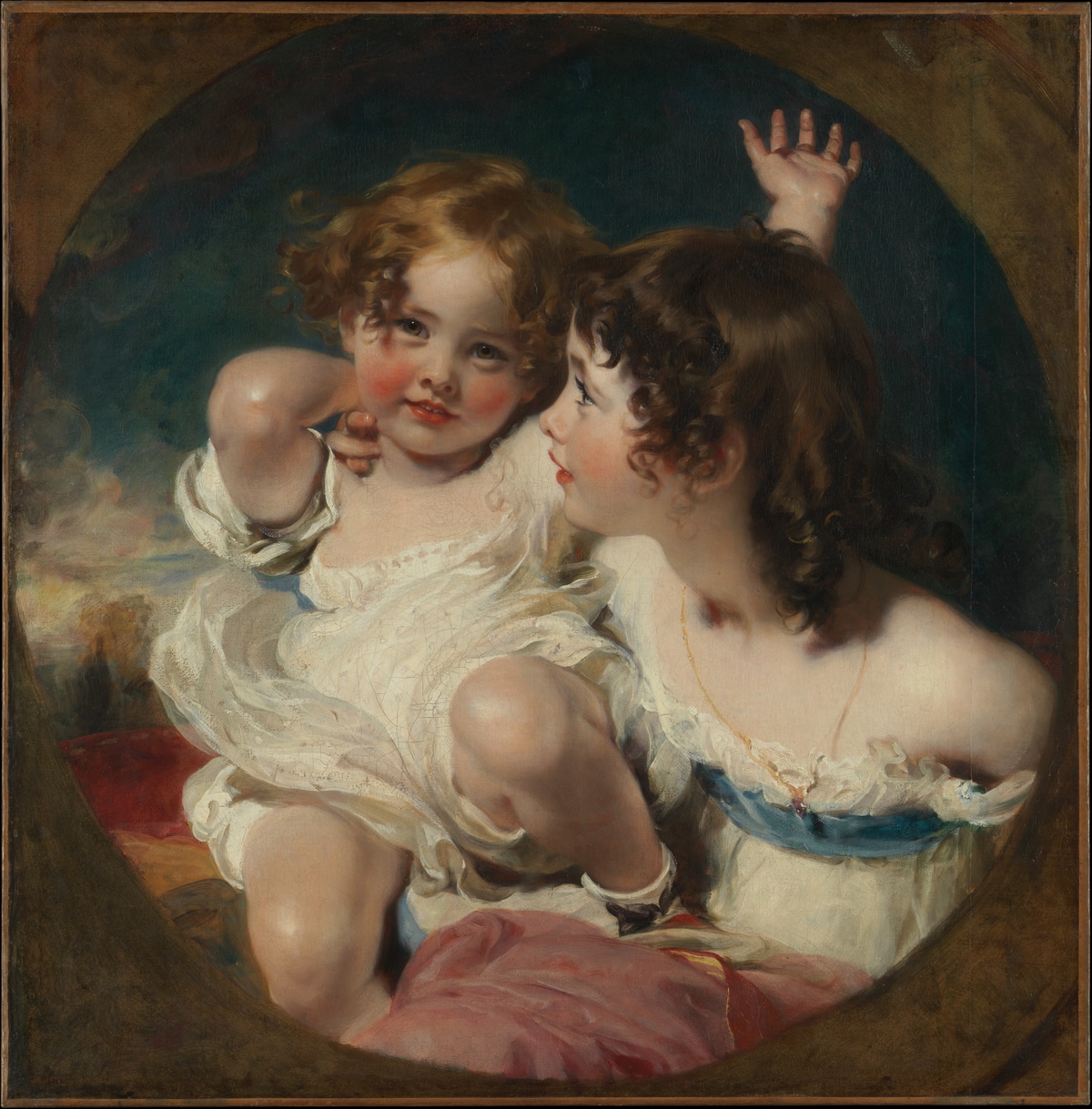I grew up in a middle-class household, and my father happened to be a successful visual artist who worked out of his home studio, sometimes at 3:00 am. If you compared my upbringing to those of my friends and classmates, you’d find that my home was one of the most well-adjusted. (Of course it was Santa Fe in the 1970’s, so everything’s relative, but still…) As a result, I took for granted that people could earn a living from the creation of art.

Looking back now, though, I realize that my father had advantages that other artists do not. His family was entrepreneurial and very driven–a temperament he clearly inherited. Although his father initially forced him into a field that he hated (physics), my grandfather relented in time, supporting Dad as he embarked on his chosen path. My father repaid the money that his father lent him to study art in NYC, but that too was an advantage, because it transformed the gesture from a handout into a business transaction.
Later, when Dad left art school, he became a commercial illustrator–a career that taught him many essential business skills, starting with how to deal with difficult people. Operating in a field that was structured around independent 1099 consulting work, he also learned how to price his work, negotiate rates, and manage his time. And because of his illustration jobs, he was able to save up enough money to finance his eventual shift to easel painting.
Not every artist, however, follows the same trajectory, or has access to the same opportunities, and that’s where the Clark Hulings Foundation comes in. We’re here to fill whatever gaps exist by providing visual artists with the tools and know-how they need to succeed at the business of art. It doesn’t matter where artists come from, how they were raised, or what kind of art they create. What matters is their will to succeed, their dedication to the work, and their eagerness to learn and avail themselves of the resources they need to get ahead.
No More Starving Artists

Most works of art travel a winding path. From their birth in a studio, they might go to a private collection, then a museum or gallery, and back again to another collection. Along the way, there are a lot of people who make money from the sale, trade, and display of those pieces, so why shouldn’t their creators have the same opportunity to earn a living from their talents and efforts?
Artists are the ultimate entrepreneurs. They take on extraordinary risk in the hopes that they will procure a return on their investment—a result that is not at all guaranteed. It’s up to the art market to determine the value of the works, and if the market sets a high value on those pieces, there is no logical reason that artists should not be fairly compensated for creating something that bears currency in the world. They should not be expected to work just for “exposure,” or to starve for the “privilege” of doing their jobs.
If we were talking about individuals or companies in other fields—the accountant who does your taxes, the farmer who grows your vegetables, or the electric company that powers your office and home—no one would question their right to be paid for the value of their output. And it is just as silly to categorize certain jobs as “business” and others as “creative.” Whether you are deciding what kind of paints to use, what crops will flourish in current soil conditions, or the best way to categorize a client’s expenses, all work requires some creativity, and all creativity requires work. Professional working artists are no different than other entrepreneurs; they all need to master business skills if they are to earn a living.
What’s a “Real” Job?
Another misperception against which artists must battle is the notion that they are less serious about their work than folks in other industries. They have often been branded bohemian dilettantes, people who stay up late, and get up even later, rolling into a studio only when the mood strikes—and not for very long—to play with paints or clay. There are, of course, artists who live down to this description, just as there are lazy office workers, and lackadaisical civil servants, but just because artists don’t work in a cubicle, and keep “unconventional” schedules does not automatically mean that they are not working at least as hard—and often twice as long, even taking on “day jobs” to pay the bills—as folks who keep “regular” business hours.
From my vantage point as the daughter of a painter, I know firsthand that the life of an artist is not a 9-to-5 existence—you don’t clock out on your art at the end of the afternoon, and inspiration can strike at 2:00 am on a Saturday—but neither is that of a nonprofit director, event producer, or any number of titles in today’s job market. Although artists work in a studio, and have fluid schedules, other professional norms still apply. Art remains a business, and like other businesses, success in the art world requires risk, effort, business strategy, marketing outreach, networking connections, organizational skills, and financial investment at crucial moments. If an artist is willing to tackle the first two items on that list, the Clark Hulings Foundation is here to help them achieve the rest.
To receive the “Director’s View” column by email each month, please sign up here.








Elizabeth, you are so on target. My children have witnessed my career as an artist – full time freelance illustrator for 33 years and fine artist in my “spare time” , painting for regional venues and juried exhibits as well as being involved as a board member for my local art association – there is no 9 to 5 schedule when it comes to art. The business side is one I stress to my children – my daughter is a dancer and physical trainer and my son a photographer/videographer – both independent contractors. They see how difficult a creative life is but also see the rewards of following your heart and working extra hard to achieve your goals. They see the support my wife, a former graphic designer, has always given me during feast or famine, so they know that you need to surround yourself with positive, motivational people. A busy illustration schedule leaves little time for bookeeping, marketing and networking but it all needs to get done. The environment you grew up in gives you an insider’s view at the artists life. It’s so good that you’re sharing your experience and expertise with everyone.
Thank you for the support, Steven. It’s a big job we’ve undertaken here, but so rewarding, and so essential! Please let us know if you would be willing to share more of your experience. That’s one way we are pushing change – by interviewing and sharing the perspectives of successful artists. You are certainly in that category, and I would love to hear from a current illustrator who can speak to the tumultuous world of publishing and the nexus of art and illustration.
Elizabeth, I’ve been doing this exactly as you describe for just over 50 years now, and everything youve said has been right on point! I have been making MY living on a roller coaster and until only recently, focused most , (but not all) of my energy just making the time to sit at my easel, much less clean, cook, run errands, shop, fix household items etc. Its starting to wear on me, but I wouldnt have it any other way ! Thanks for your observations and clarity Harry D Michael.com
Well said, Elizabeth, and thank you for standing up in defense of an artist’s right to expect pay for a job well done.
Really great post, thanks for writing it, I enjoyed the read. And that’s a beautiful piece by Clark Hulings, Wow!
Thanks Jason.
Elizabeth, great article. My Grandfather and I painted otgether until his death. He was a close friend of Clark.
Thanks for the support, Leslie. What was your Grandfather’s name?
So many of us have given up so much to be able to do what we do. The “things” that make up most people’s worlds we sacrifice. Yet we are richer in our souls than mere mortals will ever be. Grateful to read this article today.
Thank you so much for your comment, Lori. Your gracious words really mean a lot to the Fund but also to the entire team. Thank you.
Thank you so much for this! Now, if I could just get some past significant others to read this…And the painting posted is incredible!
Thank you so much, Daggi! I’m glad that you found it helpful and thought-provoking.
Reading this was like cracking open my mind and finding it on the paper in front of me. I am sometimes taken aback when repeatedly asked outright for numerous donations of art and time teaching/making art to increase my exposure, or promote art, or… (My response has generally been to say yes, which comes with its own repeat baggage!) I have wanted to sometimes suggest the ‘asker’ purchase a piece and then donate it to the fundraising effort… 🙂 Happy to see the topic covered in a compelling way in addition to your sharing of personal experience from both ends of the spectrum. Kudos!
Thanks, Gail, for your thoughtful response. Yes, artists are asked all too often to offer their work for charity or at a heavily undercut price out of expectation and perhaps misunderstanding of the exact value of their work. We hope to change that.
Thank you so much for writing this! I am a professional visual artist in Langley, BC, Canada, and agree with everything you wrote. It is wonderful to see your organization supporting artists. congratulations on doing such important work!
Thank you, Lalita, for your kind words of support!
Thanks for this clearly articulated and informative article. I have been a graphics business owner and fine artist for decades. Over the years I have seen many instances where the very same client has accepted the cost of doing business in the graphics industry yet balks at the cost of fine art. Fine art made from the very same hands. They just assume an artist’s worth is negotiable.
Mikel, this is so accurately stated. Too often fine artists’ work is undervalued and misunderstood. It is our goal at the Fund to question these commonly held beliefs and shatter them.
Thanks for sharing . I’m not sure that I gave my child all the attention I might have, if I was not an artist..but, I see that she accepts the artist in her daughter, and just might understand the life we lived a bit more. I’ll share this article with my group.
Thanks JR for your kind words and for sharing!
Bless you for this wonderful evocative piece. It quite resonates with me, being caught in the powerful currents of the realities of a professional fine artist. Sadly, many truly talented ‘potentials’ have been lost to these debilitating forces because they simply ran out of resources to pursue their dreams and passion. Yours is an angelic intervention that will hopefully lead to lots of fruitful testimonies from artists in the future. More grease and grace to you.
Thanks Abiodun!
Thanks so much Elizabeth, as an Artist practicing in Lagos Nigeria where Art appreciation and collection is relatively at its infancy, your write up was a huge encouragement. I want to expand my market and audience to the far reaches of the globe as social media has enabled me expose my work to a far larger audience. How do I collaborate with your organisation to achieve this please?
Hello Enotie, Right now, we aren’t able to collaborate extensively with organizations outside the USA. However, we encourage you to sign up for our newsletter. This will keep you up-to-date on what we are doing. Please also feel free to find us on Facebook and Twitter.
Elegant and clearly stated-
Bravo Elizabeth, none of us do this alone.
Best,
Joe Paquet
Been struggling my whole life to make a decent living as an artist, but to no avail. Worked in many other field in order to do so, but at a toll to my physical well being. Getting almost too old to even imagine it happening, but still trying at the ripe old age of 72. Art agents are far and few between and marketing skills for artists are sorely lacking. Loved you article.
Hello Dino, We, at the Clark Hulings Foundation, hope that you are able to make it work. Thanks for your comment!
I am hard core about getting paid.
Wonderful article, and enjoy your words of wisdom. As an aging fine artist, it has been difficult to maintain sanity when so many think it is a hobby. I know we work harder and longer hours when we treat our work and marketing as any professional person would do. Can’t read what I am typing as this comment box doesn’t show my words except the tops of them. I tried enlarging it with the little pull corner, but it still only shows the tops of my words. Hope what I said is spelled correctly and makes sense. Anyway, thanks for the article. I look forward to seeing more.